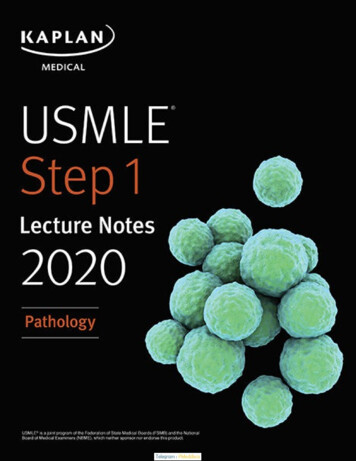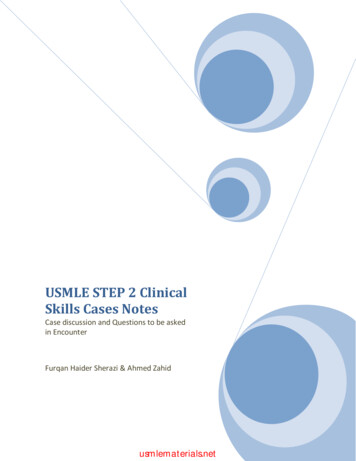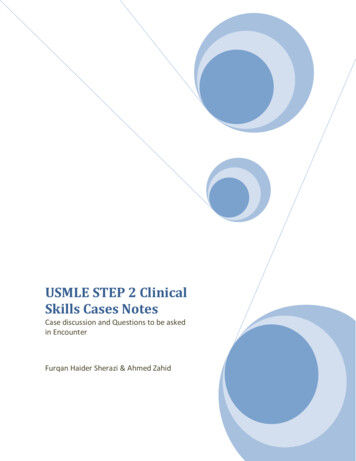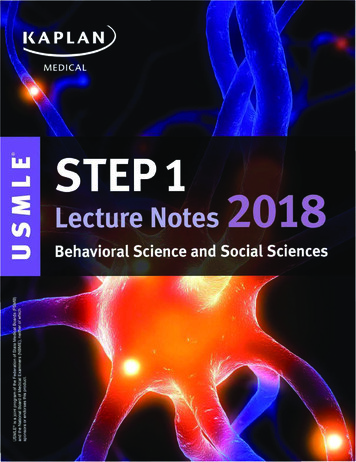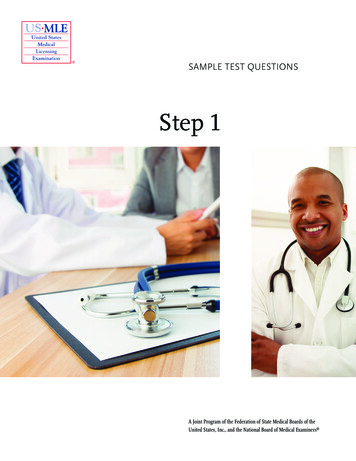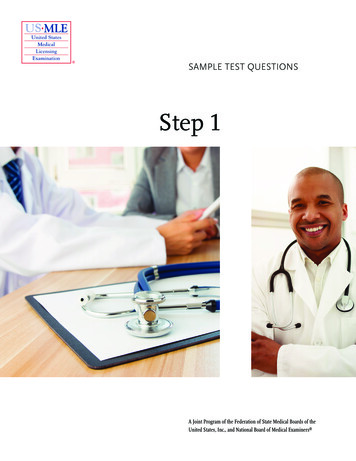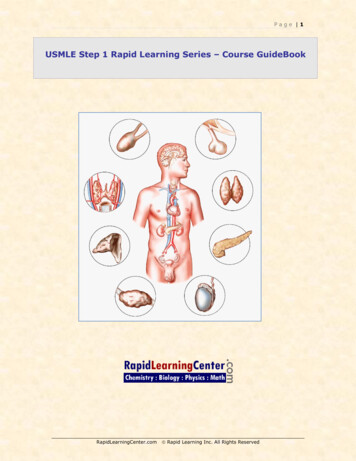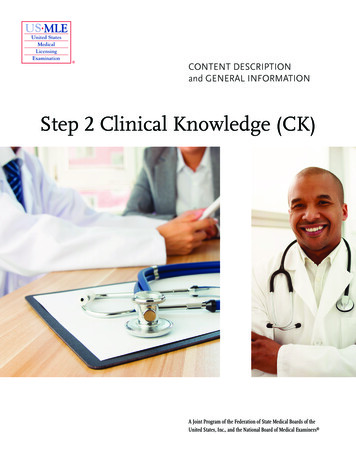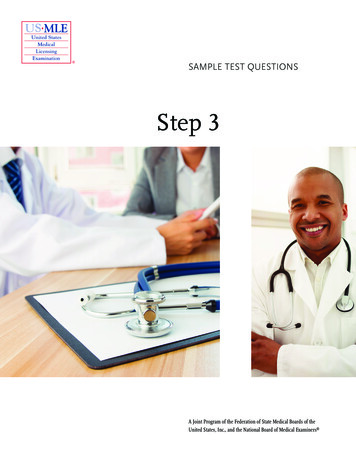
Transcription
2
3
USMLE Step 32017–2018 Lecture NotesInternal MedicinePsychiatryEthics4
Table of ContentsUSMLE Step 3 Lecture Notes: Internal Medicine Neurology Psychiatry EthicsCoverTitle PageCopyrightEditorsFeedback PageSection I: Internal MedicineChapter 1: Preventive MedicineCancer ScreeningTravel MedicineImmunizationsSmoking CessationOsteoporosis PreventionPrevention of Alcohol AbusePrevention of Violence and InjuryChapter 2: Infectious DiseaseCase 1Case 2Case 3Case 4Case 5Case 6Case 7Case 8Case 9Case 10Case 11Case 12Case 13Case 14Case 15Chapter 3: CardiologyCase 1Case 2Case 3Case 4Case 5Case 6Case 7Case 8Case 9Case 10Case 11Case 12Chapter 4: PulmonologyCase 15
Case 2Case 3Case 4Case 5Case 6Case 7Case 8Case 9Chapter 5: Emergency MedicineCase 1Case 2Case 3Case 4Case 5Case 6Case 7Case 8Case 9Case 10Case 11Chapter 6: HematologyCase 1Case 2Case 3Case 4Case 5Case 6Case 7Case 8Case 9Case 10Chapter 7: OncologyCase 1Case 2Case 3Case 4Case 5Case 6Case 7Case 8Case 9Chapter 8: EndocrinologyCase 1Case 2Case 3Case 4Case 5Case 6Case 7Case 86
Case 9Case 10Case 11Chapter 9: GastroenterologyCase 1Case 2Case 3Case 4Case 5Case 6Case 7Case 8Case 9Chapter 10: NephrologyCase 1Case 2Case 3Case 4Case 5Case 6Case 7Case 8Case 9Case 10Chapter 11: RheumatologyCase 1Case 2Case 3Case 4Case 5Case 6Case 7Case 8Case 9Case 10Section II: High-Yield Images: Dermatology, Radiology, and OphthalmologyChapter 12: DermatologyInflammatory ConditionsFungal InfectionsViral InfectionsBacterial InfectionsSexually Transmitted DiseasesMalignant LesionsScaling Disorders/Papulosquamous DermatitisChapter 13: RadiologyAppearances of Common Disorders on Chest X-RayChapter 14: OphthalmologyRetinal DiseasesKeratitisSection III: Neurology7
Chapter 15: NeurologyCase 1Case 2Case 3Case 4Case 5Case 6Case 7Case 8Case 9Case 10Case 11Case 12Case 13Case 14Section IV: PsychiatryChapter 16: PsychiatryCase 1Case 2Case 3Case 4Case 5Case 6Case 7Case 8Case 9Case 10Case 11Case 12Case 13Case 14Case 15Case 16Section V: EthicsChapter 17: EthicsCase 1Case 2Case 3Case 4Case 5Case 6Case 7Case 8Case 9Section VI: Medical AbbreviationsChapter 18: Medical Abbreviations8
9
USMLE is a joint program of the Federation of State Medical Boards (FSMB) and theNational Board of Medical Examiners (NBME), neither of which sponsors or endorses thisproduct.This publication is designed to provide accurate information in regard to the subject mattercovered as of its publication date, with the understanding that knowledge and best practiceconstantly evolve. The publisher is not engaged in rendering medical, legal, accounting, orother professional service. If medical or legal advice or other expert assistance is required, theservices of a competent professional should be sought. This publication is not intended for usein clinical practice or the delivery of medical care. To the fullest extent of the law, neither thePublisher nor the Editors assume any liability for any injury and/or damage to persons orproperty arising out of or related to any use of the material contained in this book. 2017 by Kaplan, Inc.Published by Kaplan Medical, a division of Kaplan, Inc.750 Third AvenueNew York, NY 1001710 9 8 7 6 5 4 3 2 110
EditorsINTERNAL MEDICINECharles Faselis, M.D.Chairman of MedicineVA Medical CenterWashington, DCProfessor of MedicineGeorge Washington University School of MedicineWashington, DCJoseph J. Lieber, M.D.Associate Professor of MedicineAssociate Program Director in MedicineSite Director, Internal Medicine Residency ProgramMount Sinai School of MedicineNew York, NYAssociate Director of MedicineElmhurst Hospital CenterQueens, NYFrank P. Noto, M.D.Assistant Professor of Internal MedicineSite Director, Internal Medicine Clerkship and Sub-Internship11
Icahn School of Medicine at Mount SinaiNew York, NYHospitalistElmhurst Hospital CenterQueens, NYManuel A. Castro, M.D., AAHIVSDiplomate of the American Board of Internal MedicineCertified by the American Academy of HIV MedicineWilton Health Center (Private Practice)Wilton Manors, FLNova Southeastern UniversityClinical Assistant Professor of MedicineFort Lauderdale-Davie, FLLECOM College of OsteopathyClinical Assistant Professor of MedicineBradenton, FLRaj Dasgupta, M.D., F.A.C.P., F.C.C.P., F.A.A.S.M.Assistant Professor of Clinical MedicineDepartment of Medicine, Division of Pulmonary, Critical Care and Sleep MedicineAssistant Program Director of Internal Medicine residencyAssociate Program Director of Sleep Medicine fellowshipKeck School of Medicine of USCUniversity of Southern California12
Los Angeles, CAPSYCHIATRY AND ETHICSAlina Gonzalez-Mayo, M.D.PsychiatristDept. of Veteran’s AdministrationBay Pines, FL13
We want to hear what you think. What do you like or not like about the Notes? Please email usat medfeedback@kaplan.com.14
Section IINTERNAL MEDICINE15
1Preventive MedicineCancer ScreeningRegular screening is recommended for cancers of the colon, breast, cervix, and lung.Colon CancerPatients with no significant family history of colon cancer should begin screening at age 50.The choices are:Colonoscopy every 10 years (preferred screening modality)Fecal occult blood testing every yearSigmoidoscopy with barium enema every 5 yearsPatients who have a single first-degree relative with colorectal cancer diagnosed age 60 ormultiple first-degree relatives with colon cancer diagnosed at any age should undergocolonoscopy starting at one of the following, whichever age occurs earlier:Age 40Age that is 10 years younger than the age at which the youngest affected relative wasdiagnosed16
In this group of high-risk patients, colonoscopy should be repeated every 5 years.Breast CancerThe 3 tests used to screen for breast cancer are mammogram, manual breast exam, and selfbreast exam. The American Cancer Society no longer recommends monthly self-breast examalone as a screening tool.Patients age 50, screen with mammogram (with or without clinical breast exam) every 1–2yearsPatients with very strong family history should consider prophylactic tamoxifen“Very strong family history” is defined as multiple first-degree relativesCervical CancerThe screening test of choice for the early detection of cervical cancer is the Papanicolaousmear (“Pap” test). Women should be tested annually, starting at age 21.Patients age 30, screen annually if using conventional methods or every 2 years if usingliquid-based methodsPatients age 30, screen every 2 years if 3 normal annual PAP smearsScreening can stop at age 65.Lung CancerCurrent lung cancer screening guidelines recommend the following:Patients age 55–80 with 30 pack-years of smoking, screen annually with low dose CT(non-contrast)— Must be current smoker or has quit 15 years17
Patients age 80, have quit 15 years, or have other medical problems (e.g., severe COPD)significantly limiting life expectancy or ability to undergo surgery, no screening isrecommended18
Travel MedicineHepatitisHepatitis A infection is travelers’ most common vaccine-preventable disease. Hepatitis Ainfection is possible wherever fecal contamination of food or drinking water may occur. If apatient is leaving within 2 weeks of being seen, both the vaccine and immune serum globulinare recommended.A booster shot given 6 months after the initial vaccination confers immunity for approximately10 years.Hepatitis B vaccination is recommended for patients who work closely with the indigenouspopulation. Additionally, patients who plan to engage in sexual intercourse with the localpopulace or to receive medical or dental care, and those who plan to remain abroad for 6months, should be vaccinated.MalariaFor travel to Mexico, Central America (except to Panama), or the Caribbean, chloroquine isacceptable prophylaxis for malaria. For travel to areas where chloroquine resistance iscommon, mefloquine is the agent of choice. Doxycycline is an acceptable alternative tomefloquine, although photosensitivity can be problematic.For patients who are pregnant and require chemoprophylaxis for malaria, the combination ofatovaquone and proguanil is the preferred regimen.19
RabiesRabies vaccination is recommended for travel to areas where rabies is common amongdomesticated animals (India, Asia, Mexico). Chloroquine can blunt the response to theintradermal form of rabies vaccine. Therefore, when both malaria prophylaxis and rabiesprophylaxis are required, the intramuscular form of the vaccine should be administered.Rabies vaccination is not considered a routine vaccination for most travelers.Yellow FeverYellow fever vaccine is required for travel to sub-Saharan Africa and certain South Americancountries.TyphoidTyphoid vaccination is recommended for patients who are traveling to developing countriesand will have prolonged exposure to contaminated food and water.PolioAdults who are traveling to developing countries and have never received a polio vaccineshould receive 3 doses of the inactivated polio vaccine. Patients who have been previouslyimmunized should receive a one-time booster. The live attenuated polio vaccine is no longerrecommended because of the risk of vaccine-associated disease.MeningitisPatients traveling to areas where meningococcal meningitis is endemic or epidemic (Nepal,sub-Saharan Africa, northern India) should be immunized with the polysaccharide vaccine.Additionally, Saudi Arabia requires immunization for pilgrims to Mecca. Patients with20
functional or actual asplenia and patients with terminal complement deficiencies should alsoreceive the vaccine. Meningococcal vaccine is now routine to give at age 11.DiarrheaTo prevent traveler’s diarrhea, patients should be educated regarding the advisability ofavoiding salads and unwashed fruit and drinking tap/ice water. Patients who experience loosestools without fever or blood can safely take loperamide. Treatment with a fluoroquinolone orazithromycin is reserved for patients with moderate to severe symptoms (bloody diarrhea).21
ImmunizationsInfluenza VaccineInfluenza vaccination is recommended annually for all adults, regardless of age. Additionally,those who have a history of cardiopulmonary disease, DM, or hemoglobinopathy, or who areresidents of a chronic care facility should receive an annual influenza vaccination, regardlessof age.Pregnant women who will be in their second or third trimester during the influenza seasonshould also receive the vaccine.Pneumococcal VaccinePneumococcal vaccination with the pneumococcal polysaccharide vaccine (PPSV23) isindicated for all adults age 65. Additionally, the following should receive the vaccine at anyage:Those with history of sickle-cell disease or splenectomyThose with history of cardiopulmonary disease, alcoholism, or cirrhosisAlaskan natives and certain Native American populationsThose who are immunocompromised (hematologic malignancy, chronic renal failure,nephrotic syndrome, HIV-positive; or taking immunosuppressive medications)Additionally:Those age 65 who received PPSV23 earlier than age 65 also need a booster shot if it has22
been more than 5 years since being vaccinatedThose with high risk of fatal infection (asplenic patients, immunocompromised patients,kidney disease, chemotherapy, long-term steroids, cancer including leukemia and lymphoma,organ transplant) should be revaccinated 1x after 5 yearsNo one gets more than 1 booster shot per lifetimeVaricella VaccineVaricella vaccine is a live, attenuated vaccine recommended for use in all adults who lack ahistory of childhood infection with varicella virus. Being a live, attenuated vaccine, varicellavaccine should not be given to immunocompromised patients, HIV-positive patients whensymptomatic, those with 200 CD4 cells, or pregnant women.Shingles VaccineThe shingles (zoster) vaccine is recommended routinely in order to reduce the risk of shinglesand its associated pain in people 60. Only one dose of zoster vaccine is typically given.Persons who report a previous episode of zoster and persons with chronic medical condition(chronic kidney disease, diabetes) can be vaccinated.Zoster vaccination is not indicated to treat acute zoster, to prevent those with acute zoster fromdeveloping post-herpetic neuralgia, or to treat ongoing post-herpetic neuralgia. Before routineadministration of zoster vaccine, it is not necessary to ask patients about their history ofvaricella (chickenpox) or to conduct serologic testing for varicella immunity. The zostervaccine is a lyophilized preparation of live, attenuated VZV.HPV VaccineThe quadrivalent human papilloma virus (HPV) vaccine prevents against 4 types of HPV (types6, 11, 16, 18) that are associated with genital warts and cervical cancer. It is given in 3 dosesand it is recommended for those age 11–12, but can be given at age 9.23
It is also recommended for those who did not complete the series or were never vaccinatedfrom age 13–26. Males age 9–26 might get the vaccine to prevent genital warts. Cervicalcancer screening with Pap smear should continue after vaccination.24
Smoking CessationSmoking cessation is the most preventable cause of disease. Smoking is responsible for 1 inevery 5 deaths in the United States. There are 5 steps a physician can take to help patients stopsmoking.ASK about smoking at every visit.ADVISE all smokers to quit at every visit.ATTEMPT to identify those smokers willing to quit.ASSIST smokers in quitting by setting a quit date (usually within 2 weeks) and usingnicotine patches/gum or the oral antidepressant bupropion as supportivetherapy. Varenicline, a nicotinic receptor partial agonist, can also be used to treat nicotineaddiction.ARRANGE follow-up. Provide positive reinforcement if the quit attempt was successful. Ifthe quit attempt was not successful, then determine why the patient smoked and elicit arecommitment to smoking cessation. Most patients will require several attempts beforebeing successful.U/S should be given once in male smokers age 65 in order to s
Case 1 Case 2 Case 3 Case 4 Case 5 Case 6 Case 7 Case 8 Case 9 Chapter 10: Nephrology Case 1 Case 2 Case 3 Case 4 Case 5 Case 6 Case 7 Case 8 Case 9 Case 10 Chapter 11: Rheumatology Case 1 Case 2 Case 3 Case 4 Case 5 Case 6 Case 7 Case 8 Case 9 Case 10 Section II: High-Yield Images: Dermatology, Radiology, and Ophthalmology Chapter 12 .
